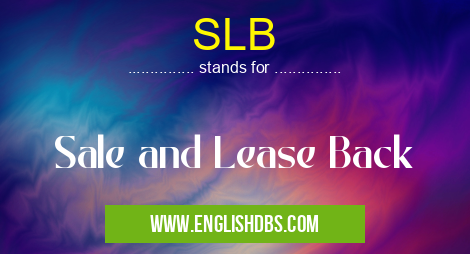What does SLB mean in UNCLASSIFIED
SLB stands for Sale and Lease Back. It is a type of financial transaction where a company sells an asset to a lessor and then leases it back from the same lessor. This arrangement can provide the company with an immediate influx of cash, while still allowing them to use the asset.

SLB meaning in Unclassified in Miscellaneous
SLB mostly used in an acronym Unclassified in Category Miscellaneous that means Sale and Lease Back
Shorthand: SLB,
Full Form: Sale and Lease Back
For more information of "Sale and Lease Back", see the section below.
Key Features of SLB
- Sale of Asset: The company transfers ownership of the asset to the lessor.
- Leaseback: The company leases the asset back from the lessor for a period of time.
- Cash Flow: The company receives an upfront payment from the lessor for the sale of the asset.
- Asset Usage: The company continues to use the asset for its operations.
Benefits of SLB
- Immediate Cash: Provides the company with immediate liquidity by selling the asset.
- Tax Advantages: Lease payments may be tax-deductible, reducing the company's tax liability.
- Asset Retention: Allows the company to continue using the asset without having to purchase it again.
Drawbacks of SLB
- Lease Costs: Lease payments can be higher than the cost of owning the asset.
- Restrictions: The lease agreement may impose restrictions on the use or disposal of the asset.
- Residual Value: The company is not entitled to the residual value of the asset at the end of the lease term.
Essential Questions and Answers on Sale and Lease Back in "MISCELLANEOUS»UNFILED"
What is a Sale and Lease Back (SLB)?
A Sale and Lease Back (SLB) is a financial transaction in which a company sells an asset to an investor and then immediately leases it back. The company receives a lump sum of cash from the sale and continues to use the asset in its operations.
What are the benefits of a SLB?
SLBs offer several benefits, including:
- Immediate cash inflow for the company
- Reduced balance sheet debt
- Potential tax advantages
- Preservation of ownership and control of the asset
What are the drawbacks of a SLB?
SLBs also have some potential drawbacks, such as:
- Lease payments can be higher than loan payments
- The company may have less flexibility in using the asset
- The lease may restrict the company's ability to sell or mortgage the asset
Who typically engages in SLBs?
SLBs are commonly used by businesses, real estate investors, and government entities. They can be beneficial for companies seeking to unlock the value of their assets and raise capital.
What are the tax implications of a SLB?
The tax implications of a SLB depend on the specific circumstances and tax laws of the applicable jurisdiction. Generally, the sale of the asset may trigger capital gains tax, while the lease payments may be deductible as an expense.
How are SLBs structured?
SLBs can be structured in various ways, depending on the needs of the parties involved. The most common structure involves a sale-leaseback agreement between the company and the investor. In some cases, a third-party lessor may be involved.
Are there any alternatives to SLBs?
Yes, there are several alternatives to SLBs, including:
- Equipment financing
- Asset-backed lending
- Equity financing
Final Words: SLB can be a useful financing tool for companies seeking to raise capital and simultaneously retain the use of an asset. It is important to carefully consider the benefits and drawbacks before entering into an SLB agreement.
SLB also stands for: |
|
| All stands for SLB |
